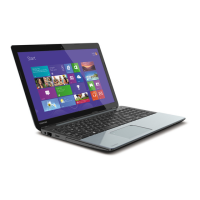
Do you have a question about the Toshiba Satellite S50-A Series and is the answer not in the manual?
| Display | 15.6-inch |
|---|---|
| Bluetooth | Bluetooth 4.0 |
| Webcam | HD Webcam |
| Optical Drive | DVD SuperMulti Drive |
| Processor | Intel Core i5 or i7 (4th generation) |
| RAM | Up to 16GB DDR3 |
| Resolution | 1366x768 or 1920x1080 |
| Graphics | NVIDIA GeForce GT 740M |
| Operating System | Windows 8.1 |
| Wireless | Wi-Fi 802.11b/g/n |
| Ports | USB 3.0, USB 2.0, HDMI, Ethernet, Headphone/Mic combo |
| Battery | Lithium-ion |
Details copyright, disclaimer, and trademark information for TOSHIBA computers.
Provides FCC and other regulatory compliance information for the computer.
States compliance with European Directives and CE-Marking information.
Lists hardware and documentation included with the computer for setup.
Provides basic information and steps for initial computer setup and use.
Explains how to connect the AC adaptor for power and charging.
Describes the procedure for powering on the computer.
Explains how to use Sleep Mode to interrupt work and save power.
Describes Hibernation Mode for saving system state and power.
Identifies components on the computer's front when the display is closed.
Identifies ports and components on the computer's left side.
Identifies ports and components on the computer's right side.
Describes the computer's internal hardware components.
Explains LED indicators for power and battery status.
Explains how to use the touch screen with gestures like tap and pinch.
Describes keyboard layout, keys, and indicators like CAPS LOCK.
Explains how to use the remote controller for computer functions.
Describes optical disc drive types and how to use them.
Explains battery types, use, recharging methods, and handling.
Describes how to connect and disconnect to a Local Area Network.
Details how to install and remove additional memory modules.
Explains how to connect and use external displays like monitors.
Describes audio control functions like volume and sound effects.
Describes pre-installed utilities and how to start them.
Configuration management tool for customizing hardware settings.
Monitors system functions like power, battery, and cooling.
Details unique and advanced features for computer convenience.
Information on system recovery options and creating recovery media.
Provides guidelines for effectively resolving computer problems.
Offers questions to help identify the cause of computer malfunctions.
Discusses problems related to computer hardware and peripherals.
Provides information on how to contact TOSHIBA for technical assistance.
Summarizes the computer's technical specifications.
Details wireless technology interoperability and health considerations.
Defines terms and abbreviations used in the manual.









